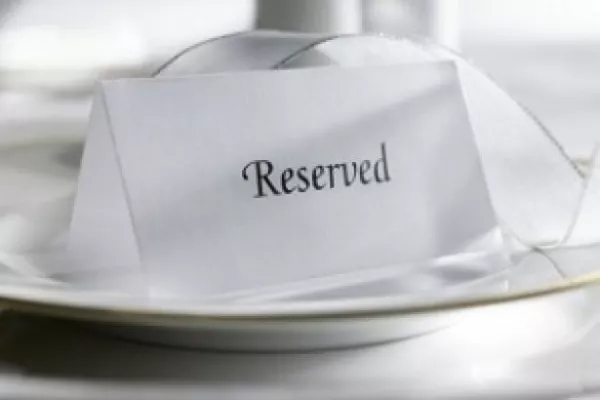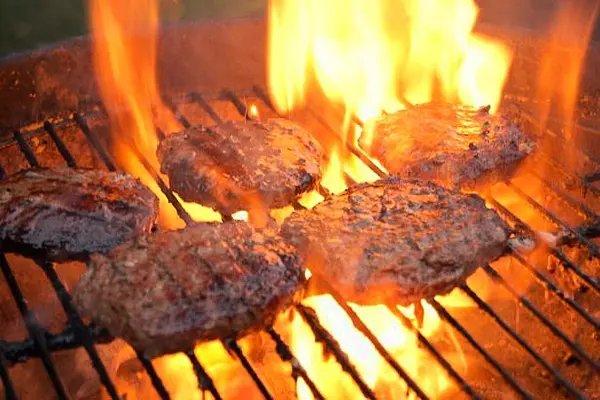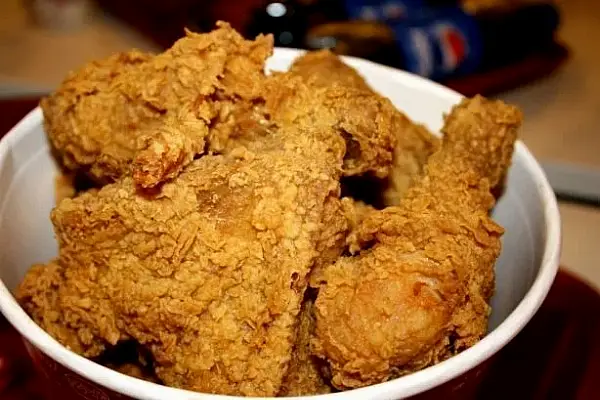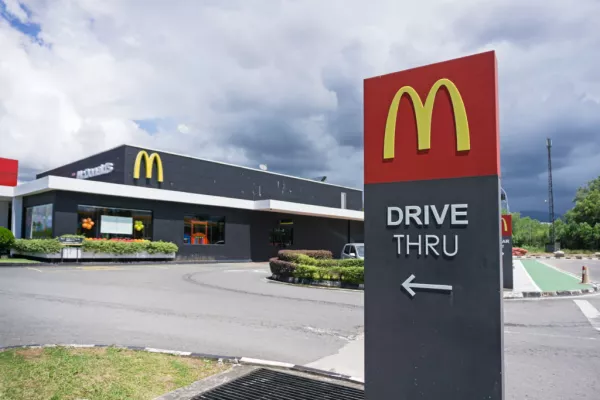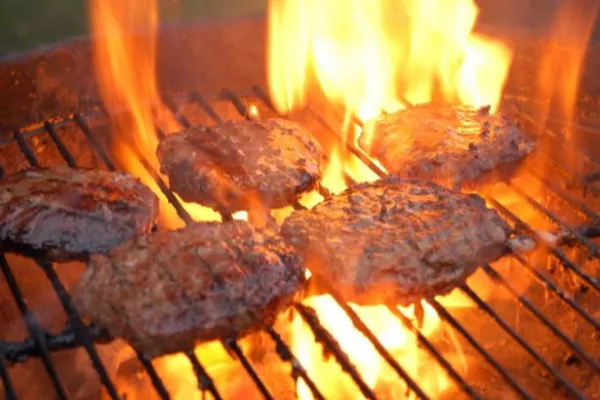For some of us, 2016 has come out of nowhere to be a surprisingly good year for restaurants.
In New York, Le Coucou from chef Daniel Rose and restaurateur Stephen Starr has blown everyone away with its elegant Frenchness; it’s one of the best openings the city has seen in the past several years. In San Francisco, In Situ is a brilliant incarnation of the greatest hits of some of the world’s best chefs, via French Laundry alum Corey Lee. We got our last look at Noma in Copenhagen before it closes and reincarnates itself in a new location.
On the other hand, for those of us who indulge in the strange joy of occasionally encountering a comically bad restaurant, it was only an OK year. A highlight was surely when Vanity Fair asked if Trump Grill could be the worst restaurant in America. (Quid pro quo: Menus at Waverly Inn, the restaurant from VF’s Graydon Carter, are inscribed with this quote: “Waverly Inn—worst food in city”—Donald Trump.)
This little bright spot made us wonder: What have been the best worst restaurant reviews in recent history? Here’s my Top 10 list, annotated with updates from some of the critics who came out swinging. I’m sure I’m missing something. Let me know what on Twitter: @kkrader.
And happy dining in 2017. May you find yourself at a bad restaurant only on purpose.
10. Tavern on the Green by Ryan Sutton for Eater
Overview After New York’s most iconic dining destination got a $38 million makeover and installed a new chef, Sutton went to check it out in 2014. He filed a story that noted the importance of it as an institution and the lovely peacefulness of sitting in the new glass atrium when it rained. Until the food arrives. 'Tavern on the Green Is a Bad Restaurant’ is the title of his review.
Notable Dish Gruyère and goat cheese sandwiches. “Two tiny halves, for $14, boast more grease than a lube job.”
Best Line “… a venue whose $22 mac 'n' cheese is real prison slop. And when the waiter upsells you into topping it off with salmon—because what's better than oily fish to pair with cheese-y, mushy, pasta—you'll have spent $32 on what is surely one the worst things anyone can eat outside of Rikers.”
Update "This was my first super negative review for Eater," Sutton said over the phone. "One of the fun things to know about it is that journalists famously don't write their own headlines. But I wrote this one. As a critic you don't want to tell people not to go to a restaurant; you want them to come to their own decision. But I did hope that I was pushing people in that direction."
9. Founding Farmers by Tom Sietsema, the Washington Post
Overview: The self-described "urban farmhouse" has locations around the D.C. area, the most notable one near the White House. “One of Washington’s busiest (but also most dispiriting) dining rooms,” described Sietsema, the longtime Washington Post critic, in an e-mail. Founding Farmers' mission statement is extreme farm-to-table; Sietsema had only given one zero-star review before he bestowed that honor on FF in January 2016 for such dishes as Many Vegetable Mushroom Lasagna, for which, he concluded, “salt must be a vegetable.”
Notable Dish: Shrimp and Grits. “Had my waiter inquired, my posse would have told him the swamp posing as shrimp and grits was about as close to the southern model as rap is to opera.”
Best Line: “'I feel like I’m in a cafeteria,' a companion says on a recent weeknight on the second floor, where a flock of ceramic birds floats above our heads. (I would envy them their freedom, but they’re just as stuck here as we are.)”
Update: Sietsema remembers well the ugly process of performing the review: “I went back—seven visits total—getting angrier with each meal. Founding Farmers promoted itself as farm-to-table, despite overwhelming evidence it was more farm-to-fable. Much to my surprise, the Founding Farmers review went viral, trending on Twitter and becoming the No. 1 story on the Washington Post site. 'They’re reading you in China and Russia,' I recall a top editor telling me.”
8. Olive Garden by Jonathan Gold, LA Weekly
Overview: In 2011, L.A.’s legendary critic got stuck in L.A.’s legendary traffic—and so was unable to intercept a photographer before she walked into an area of Olive Garden in what was supposed to be a hilarious April Fool’s Day prank by Gold. By the time he arrived, she had already found a table and dug into the basket of bread sticks “slicked with grease and oil.” So he joined her and performed an earnest review.
Notable Dish: Eggplant parmigiana. “It consisted of crunchy eggplant Pringles bound with leathery straps of mozzarella.”
Best Line: “I would like to say … the tenderness of the fried calamari was greater than the sogginess of its breading. I would also like to report that the lasagna rollata al forno was just as good as the remarkably similar lasagna cupcakes from Silver Lake caterers Heirloom L.A. ... They weren't, though—they just weren't.”
Update: “I haven’t been back, which probably doesn’t surprise you,” Gold told me. “I got so many letters calling me elitist, although Olive Garden is actually more expensive than good Italian restaurants. (Advertising and McTuscan architecture cost real money.)”
7. Jay Rayner on Quattro Passi, the Guardian
For some critics it’s easy to spotlight their cruelest review; for others it’s a challenge because even their glowing reviews can sound cranky. The Guardian’s hilarious Jay Rayner is 100 percent in the latter category. Amid close competition, the story he wrote about the very pricey Quattro Passi in London’s W1 neighborhood in 2014 was the winner.
Notable Dish: Potatoes. “I tried to imagine the meeting where they priced a bowl of poorly roasted new potatoes—oily, sweaty, soft-skinned, as though cooked a while before and then reheated to order—at £6. Did they urge each other ever higher, giggling as they calculated the enormous gross profit?”
Best Line: “I have no problem spending big money on meals out. I’ve paid more than £282 of my own dosh for lunch. It just needs to be utterly memorable. ... It can’t be a pallid fart of mediocrity, priced for some dodgy clientele that’s ripped off the gross national product of a small impoverished nation and is now domiciled in London for tax reasons. That’s what your money gets you at Quattro Passi: clumsy cooking, trying to make itself look grown up and clever, generally by the application of flaky precious metals, like King Midas has suffered psoriasis over your dinner.”
6. Montana's Trail House by Joshua David Stein, the Observer
Overview: The headline reads: "Montana’s Trail House Brings Morally Hazardous Appalachian Cuisine to Brooklyn." In a 2014 review that awarded the place zeros stars, Stein simultaneously called out the problems of glamorizing a destitute region of the country and the speedy gentrification of Bushwick. “It’s rottenness is both inherent and cosmetic; it is culinarily insipid and morally insidious,” said Stein of the restaurant. “It’s bad to the last splinter of its Kentucky wood.”
Notable Dish Fried chicken. “Alas, there’s just the sort of generic Southern food you find at nearly every restaurant with “The” or “&” in the name: a totally underwhelming fried chicken, leg and thigh both as greasy as a teenage boy’s T-zone, offered for $18.”
Best Line: “There is a deeply toxic relationship with history and with America embodied at Montana’s Trail House. One need not be from Appalachia to object to the fetishization of that impoverished region for the blithe consumption of faux Brooklyn frontiersmen and women.”
Update: Stein reflected back on the review, via e-mail: “I got a lot of, 'Why so serious?' in response to my admittedly somewhat hysterically shrill review. But privilege and ignorance shows itself in myriad ways, both serious and seemingly trifling. ... Could I have been kinder? I could have been, and, probably, I should have been. But the fundamental issues embodied in that restaurant are now more important than ever before.”
5. Tao by Ryan Sutton for Bloomberg
Overview: In a review he wrote for us in 2013, Sutton travelled to the Meatpacking District to check out the then-new outpost of the fusion restaurant Tao. It’s the downtown sibling to one of the country’s highest grossing restaurants. There, Sutton observed that the menus highlight the teachings of the spiritually enlightened Buddha, while schilling Johnnie Walker Blue at $800 per bottle.
Notable Dish: Wagyu beef. “With ‘sophisticated dips and sauces,’ it has scant more tenderness or flavor than a $10 steak from Pathmark. Here, you pay $88 for the privilege.”
Best Line “Kudos to the owners … for turning the Siddhartha, one of history’s great proponents of self-deprivation, into Paris Hilton.”
Update: "I'm super proud of this review," said Sutton over the phone. "It wasn't a slam on the food—I gave the place 1/2 star. Because people do have fun. It was a takedown of the ideas that underpin Tao and their culture of "nouveau Orientalism." Tao was trying to tell the false story of the East as a 24-hour, hedonistic bacchanalia, which was absolutely nuts. I went big against that."
4. Harry Cipriani by Frank Bruni, the New York Times
Overview: Bruni, the Times’s legendary restaurant critic in the heady 2000s, awarded the Italian restaurant a remarkable rating of Poor in 2007. He did, however, concede that the people-watching was unparalleled. “You rarely see blondness this improbable, cosmetology this transparent, wealth this flamboyantly misspent,” he concluded.
Notable Dish: Potatoes. “I’m taking it on faith that they were potatoes. That’s what they visually suggested, those desiccated yellow-beige coins that had somehow acquired the texture of Brillo and could almost have been used to scrub whatever pan they had emerged from.”
Best Line: The opener: “Over the years the Cipriani restaurant family and its employees have faced charges of sexual harassment, insurance fraud and tax evasion, the last leading to guilty pleas by two family members in July. But the crime that comes to mind first when I think of the Ciprianis is highway robbery.”
Update Bruni recalls the restaurant over e-mail: “You know what still makes me laugh, and cringe, all these years later? The way every item on the menu, or at least many items, had a price ending in $.95, as if it were a gallon of gasoline and as if NOT rounding the spaghetti up to the nearest dollar would somehow distract a diner from realizing that he or she was spending a semester's tuition at Dalton for flaccid pasta in a wan sauce.”
3. Guy’s American Kitchen & Bar by Pete Wells, the New York Times
Overview: Perhaps the most famous restaurant critique of all time, written by Wells in 2012 as a long-form question-filled poem to Guy Fieri on the subject of the TV food star’s Times Square restaurant.
Notable Dish: Lots, but here’s one: “Were you struck by how very far from awesome the Awesome Pretzel Chicken Tenders are? If you hadn’t come up with the recipe yourself, would you ever guess that the shiny tissue of breading that exudes grease onto the plate contains either pretzels or smoked almonds?”
Best Line: Too many; here’s one: “Hey, did you try that blue drink, the one that glows like nuclear waste? The watermelon margarita? Any idea why it tastes like some combination of radiator fluid and formaldehyde?”
2. Trump Grill by Tina Nguyen, Vanity Fair
Overview: One of the very best worst reviews is also the newest. Ngyuen, whose regular beat is politics, took note of everything, from the bathroom situation that she compared to lining up for essentials in Venezuela to the fact that a pig’s eyeball she once ate on a dare tasted better than the Trump Grill’s Gold Label Burger. She waxes especially eloquent on the faux lavish touches all around the lobby-style restaurant, such as the French-styled art décor that looks as though it were actually purchased at a Home Goods. She uses this as the occasion to cite a now-famous Fran Lebowitz quote, that Trump “is a poor person’s idea of a rich person.” Vanity Fair reportedly got 13,000 new subscribers within 24 hours of the story running after Trump tweeted angrily in response.
Notable Dish: Filet mignon. “The steak came out overcooked and mealy, with an ugly strain of pure fat running through it, crying out for A.1. sauce (it was missing the promised demi-glace, too). The plate must have tilted during its journey from the kitchen to the table, as the steak slumped to the side over the potatoes like a dead body inside a T-boned minivan.”
Best Line: “The allure of Trump’s restaurant, like the candidate, is that it seems like a cheap version of rich. The inconsistent menus—literally, my menu was missing dishes that I found on my dining partners’—were chock-full of steakhouse classics doused with unnecessarily high-end ingredients."
1. L’Ami Lous by A.A. Gill, Vanity Fair
Overview: Finding the best worst review by the acerbic and brilliant critic Gill (recently deceased) is no small feat. There’s the one that begins, “Why is there never a good Palestinian suicide bomber when you need one?” Or the review of 66 in New York: “Tell me, off the top of your head, what two attributes should hot-and-sour soup have? Take your time. It was neither.” But Gill’s most infamous restaurant excursion is to the Paris brasserie L’Ami Louis in Paris in 2011, where he bemoaned the clientele, the oh-so-French service, and especially the food with such dishes as snails—which he compared to dinosaur boogers.
Notable Dish: Foie gras. “After 30 minutes what come are a pair of intimidatingly gross flabs of chilly pâté, with a slight coating of pustular yellow fat. They are dense and stringy, with a web of veins. I doubt they were made on the premises. The liver crumbles under the knife like plumber’s putty and tastes faintly of gut-scented butter or pressed liposuction.”
Best Line: “As an afterthought, or perhaps as an apology, the waiter brings a funeral pyre of French fries—they taste of seared and overused cooking oil—and then a green salad of frisée and mâche, two leaves that rarely share a bowl, due to their irreconcilable differences.”
News by Bloomberg, edited by Hospitality Ireland
